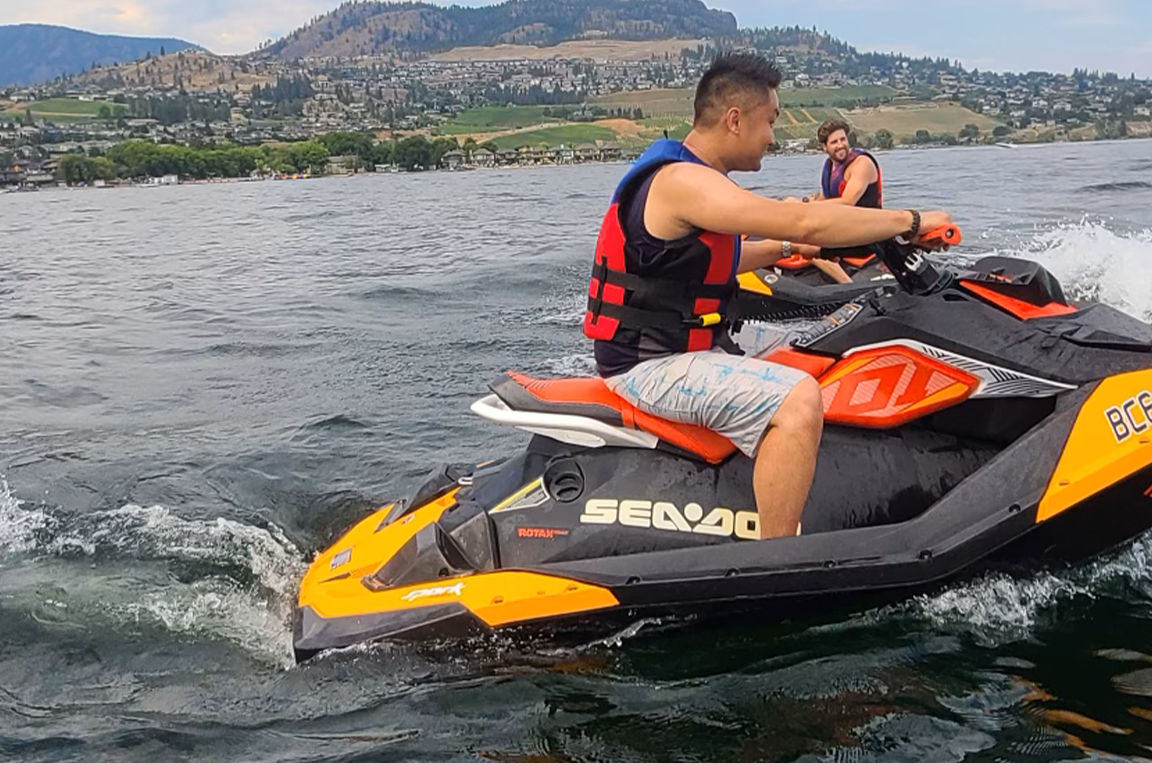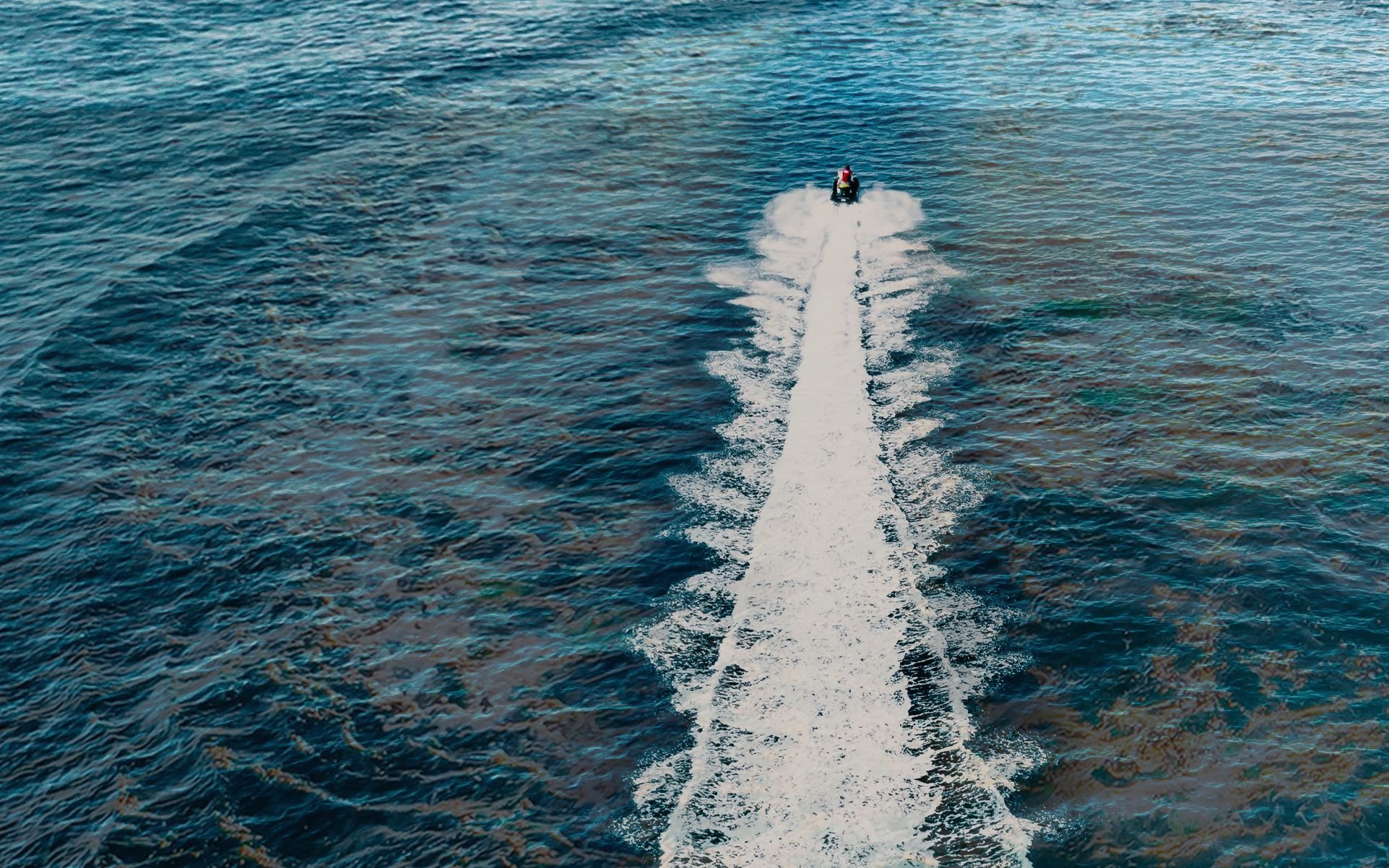
SEA-DOO Safety
Safety
To stay safe on the water, riders should always be aware of their surroundings, follow local laws and regulations, and wear a life vest and neoprene shorts. Additionally, they should check the weather forecast before heading out.
-
Know your watercraft’s passenger and weight capacity—most models seat three, except for the 2-up SPARK, SPARK TRIXX, and RXP-X. Exceeding capacity affects handling.
Ensure all passengers can swim and wear a Coast Guard-approved life jacket and neoprene shorts or a wetsuit. Practice reboarding from deep water before heading out.
The driver must sit closest to the controls—never place a child in front. Passengers should sit inline, feet planted, and use grab handles or hold onto the rider ahead.
Drivers are responsible for passenger safety. Alert them before accelerating, turning, encountering waves, or braking.
Finally, never apply throttle with a passenger in the water. Shut off the engine and disconnect the safety lanyard when anyone is off the craft.
-
Prepare for Docking: Check the dock, wind, and current conditions.
Install Fenders: Attach Sea-Doo Snap-In Fenders to prevent damage.
Approach the Dock: Approach slowly at a 20-30 degree angle. Use gentle throttle and the reverse function if needed. Align your Sea-Doo parallel to the dock and reduce speed as you get close.
Secure Your Sea-Doo: Use the integrated tie-downs to attach dock lines, securing your craft with one line at the bow and another at the stern.
Avoid Damage: Don’t loop lines around the steering column or grab handles to prevent wear.
Handle Different Docks: For floating docks, adjust your approach for water movement; for fixed docks, secure tightly to handle tidal changes.
Overcome Challenges: Approach into the wind, dock against strong currents, and be patient at crowded docks.
Post-Docking Care: Rinse off your Sea-Doo to prevent corrosion and check for any damage.
With practice, you'll master smooth, safe docking every time!
-
No, never run your Sea-Doo motor out of the water. The engine’s cooling system relies on water for temperature control, and running it without water can damage internal components. The only exception is after riding in saltwater to flush the engine, but don’t run the motor for more than 30 seconds. Always start your Sea-Doo in at least three feet of water to avoid debris damage.
-
To choose the perfect life jacket for your Sea-Doo ride, consider your riding style and needs. Here's a quick guide:
High-Performance Riders: Go for the Airflow PFD for lightweight, quick-drying comfort and great airflow.
All-Day Comfort: The Freedom PFD is ideal for all-day recreation, offering comfort and flexibility.
Long-Distance & Fishing: Choose the Explorer PFD for durable construction, storage, and a built-in camera mount.
Everyday Rides: The Navigator PFD fits multiple riders and offers comfort with large arm holes and dual sizing.
Budget-Friendly: The Motion PFD offers safety and comfort at an affordable price, with adjustable fit and large arm holes.
Youth Riders: The Jr. Explorer or Kids’ Sandsea are perfect for kids, offering comfort and durability for watersports.
-
To get back on a Sea-Doo after falling off:
Stop the Engine: Ensure the engine is off. If you fell off, the safety lanyard should have stopped the engine. If you're a passenger, have the driver stop the engine and disconnect the safety lanyard.
Swim to the Stern: Approach the back of the craft and use the rear grab handle. Pull yourself up until you can place a foot on the boarding step (if available).
Climb Aboard: Use the step or grab handle to get a knee on the swim platform, then climb into a seated position on the saddle.
If your craft lacks a boarding step, use your upper body strength to pull yourself aboard. Practice this process before your first ride to avoid surprises. Consider adding a boarding step if your Sea-Doo doesn't have one.
Environment
As Sea-Doo riders, we respect the waterways by staying clear of shorelines and swimmers, avoiding prohibited areas, and being mindful of marine life.
-
You can ride a Sea-Doo on both fresh and saltwater, including lakes, rivers, and oceans. Start by exploring local lakes, rivers, and beaches, and join local boating clubs or online forums to discover nearby spots. As you gain experience, you may want to venture further to explore new adventures, from island hopping to fishing, wakeboarding, and snorkeling.
Always bring essentials like food and water, and ride safely for the best experience.
-
Respecting wildlife is crucial for maintaining a harmonious relationship with the environment. Here are some tips:
Avoid Wildlife Harassment: Never chase or disturb animals like sea otters, manatees, or whales. Ride at safe speeds to prevent injury.
Minimize Noise: Stay clear of bird nesting areas and reduce noise to avoid disturbing wildlife, especially migratory birds and nesting birds.
Prevent Erosion: Follow no-wake zones and avoid high-speed riding near shorelines to protect habitats from erosion.
Wash Your Sea-Doo: Clean your Sea-Doo after each use to prevent the spread of invasive species, ensuring the protection of local ecosystems.
By following these guidelines, Sea-Doo riders can help preserve natural habitats and protect wildlife.
-
Yes, there are several environmental restrictions for Sea-Doo riders to ensure the protection of water ecosystems:
Avoid Pollution: Always refuel on land to prevent spills, and clean engines away from shorelines to avoid contaminating the water.
Limit Turbidity: Ride in deeper waters and maintain a low speed in shallow areas to prevent stirring up sediments, which can harm aquatic life.
Stay Away from Sensitive Habitats: Avoid areas with delicate vegetation like sea grasses, mangroves, and coral reefs, as they are essential to marine ecosystems.
Etiquette
Riding etiquette is about ensuring the waterways are safe for everyone. This includes reducing noise in residential areas, controlling your speed, and keeping a safe distance from swimmers and other boaters.
-
Meeting Head-On: Both boats should keep to their right (starboard) side to pass safely.
Approaching from Behind: Maintain a safe distance and pass only when it's clear. In narrow channels, pass on the right.
Encountering at Right Angles: The boat on the right has the right of way. Slow down or stop to yield if needed.
Riding Near Other Boaters: Keep a 200’ distance and slow down when approaching stopped boats or PWCs.
Avoid Jumping Wake: It’s not only unsafe but also illegal in many areas.
Always stay alert, follow the rules, and drive defensively to ensure safety on the water.
Why Choose Us?
No Hidden Fees: What you see is what you pay. No surprises here.
We’ve Got You Covered: We offer life jackets, dry bags and waterproof phone cases for your safety and convenience.
Choose Your Launch: We deliver to a Kelowna or West Kelowna boat launch near you.
Fully Licensed and Insured: Enjoy peace of mind with our professional and legally compliant business.
Elite Sea-Doo Fleet: Experience the thrill of our SPARK TRIXX and GTX PRO models.
Easy Online Booking: A few clicks and you’re set for an exhilarating ride on the lake!




